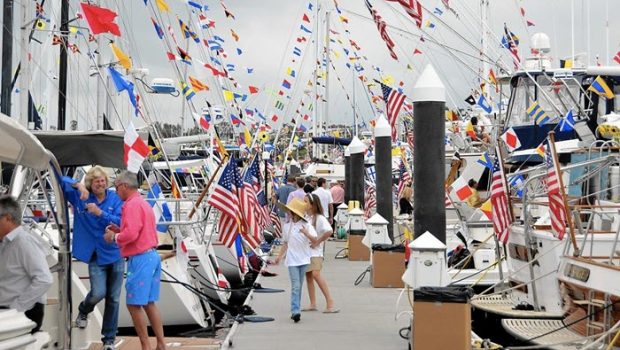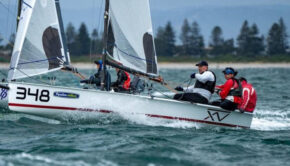Going to school on nautical flags
Published on March 25th, 2021
With easing COVID-19 health restrictions, it is with hope that yacht clubs across North America can host their traditional Opening Day events. Central to the festivities is the dressing of yachts in colorful flags, but what’s the story with these flags? Here’s some background by Liza Brooke:
Whoever being on a boat has must see those weird colorful flags. Those flags are not just for the decoration. They are there for a purpose on almost 30 million boats. These flags are called ‘Nautical Flags’. These 26 square flags are a visual signal holding a specific meaning. Each flag represents an alphabet.

They are also used to show warning signs to distant ships, and to even communicate with them. These are the international code system, so if you are a new sailor, you must master them. Hang on I’ll provide you complete details regarding the flag and the functions of each flag.
1. Nautical Flags
Nautical flags are the special name given to the international code system of communication in between the ships. These are the 26 square shape flags present in every boat. Each flag presents an alphabet along with ten numeric pendants also.
Among them, one is the answering pendant, and the other is substitutes or repetitive pendants. The vision is blurred and limited in the sea. Therefore, you will only see limited colors in these flags. These limited colors are; blue, red, yellow, black and white.
The purpose is to create a visible distinction between the colors that cannot be mixed. One flag signals are considered to be urgent or common singles. The rest are considered as identification of the ship.
2. Why know about it?
So why is it important for you as a sailor to know about the nautical flag? Imagine yourself stuck in an emergency with no working radio or firecracker.
How will you call or send a signal? At that time the nautical flags are used to grab the attention of other ships. Not only this, if you are dealing with terrorism or any harmful activity, you can see these flags as a warning sign.
These flags are also considered as an acceptable way of sending secret military codes. No, I am not making you scared, but it was created for such purpose. I’ll explain that later.
Communication, initiation signal and other indicators are also conveyed by using these flags.
As responsible for the ship and the ship captain, you must know all of these signals. So, in an emergency, you can save the life of your boat members.
3. History of Nautical Flag
There are many stories behind the creation and historical usage of the nautical flag; the most authentic one is I am going to mention here.
The last evidence of nautical flag creation was for military communication during the world war. It started as a limited communication between the battleships is now converted into the international code system.
Another perspective of creation is for recreational vessels and communication between the common purpose ships. Please don’t get confused I’ll explain you each of the historical creation in a sequential manner.
Military Origin
Initially, it was used to give specific signals to other ships during a naval war, but it was limited. Therefore, in the 1700s during the Anglo-Dutch naval wars, the flag signals were more enhanced. This converts into a permanent way of single transferring by the Royal Navy.
They use 11 different flags to send almost 45 messages. The evidence of the first code for flag signal was prepared by a Frenchman, Mahé de la Bourdonniase in 1738. In later years the numeric codes were included which broaden the horizon of signal sending.
 Ships of War
Ships of War
The nautical flag was created and have served a crucial role in different wars. However, the process of evolution and recreation was continuous. The first documented form of nautical flag code was written in the book ‘Signal Book for Ships of War’ in 1799.
This was written after the notable modifications made by Richard Earl Howe in the year 1783. The Royal Navy later used these in the Napoleonic Wars.
After the first book of signals the series continues, many US writers wrote the signal after the Britain writer.
Captain Frederick Marryat wrote the first commercial book to be ever published in 1817 named ‘Code of Signals for the Merchant Service’.
International Code Signal
The international code system was created to be used by every boat in the water. Well, I guess that’s a tough one for the people like me habitual of cheap essay writing services.
These codes were established in the year 1855 and were public in the year 1857. Do you know who made all of these efforts? The British Board of Trade did.
They created almost 70,000 signals and 17,000 messages that can be created by only using 18 flags. Well, the whole world has played their role in creating this international code.
The code was revised in different conferences the most notable one was done in the International Radiotelegraph Conference of Madrid in 1932.
This is how the whole nautical flag system was derived. More codes and signals were added as it crosses the linguistic border.
4. Nautical Flag Meaning
Now this one is the learning part. Every flag denotes an alphabet, so there are a total of 26 alphabets and 26 different flags.
Well, that a tough one, I guess. But you don’t have to worry about that memorize it slowly. The quantity of the flag also illustrates a different meaning.
If there is a single flag, it means a common signal. But what is more than one? It denotes distress.
Three flags are for the compass, bearings or even punctuation. Yes, you have to use them when giving elongated signals.
 If there are four flags, then it is the name or geographical location of the ship. Five flags relate the time and position. Six flags represent the latitude and longitude, and seven flags represent 100 degrees.
If there are four flags, then it is the name or geographical location of the ship. Five flags relate the time and position. Six flags represent the latitude and longitude, and seven flags represent 100 degrees.
5. Nautical Flag Angle
Till now, we get all the details regarding the nautical flag and its significance. But the question that arises here is how to place the flag? There is an angle for that.
 There are two poles placed at exact 90° on the boat. Now intersect both the poles creating a cross sign. These intersection poles shall be perpendicular to each other. Now place the main flag at the top and nautical flags below the flag like one shown in the illustration.
There are two poles placed at exact 90° on the boat. Now intersect both the poles creating a cross sign. These intersection poles shall be perpendicular to each other. Now place the main flag at the top and nautical flags below the flag like one shown in the illustration.
Bottom Line
Sailing has become more convenient in contrary to the initial days. There is much technological advancement made since then to facilitate new sailors.
But still, you need to learn the traditional methods. Nautical flags are one of them. If you find it difficult, think once for the naval forces used in the war. Though, these are simple the flags. But it is a notable contribution of Royal naval forces in sailing. So if you desired to be a professional sailor, you have to learn all those signals and messages. If you can’t memorize all those, you have to learn at least the basic one.
Author’s Bio
Liza Brooke is working as a Senior Research Analyst & Tech Blogger at FreeEssayWriters. She is passionate about conducting research. She is habitual of extracting deep insights in her research to deliver the most unique and appropriate knowledge to her readers. Her passion for writing is visible from the depth of her articles.












 We’ll keep your information safe.
We’ll keep your information safe.